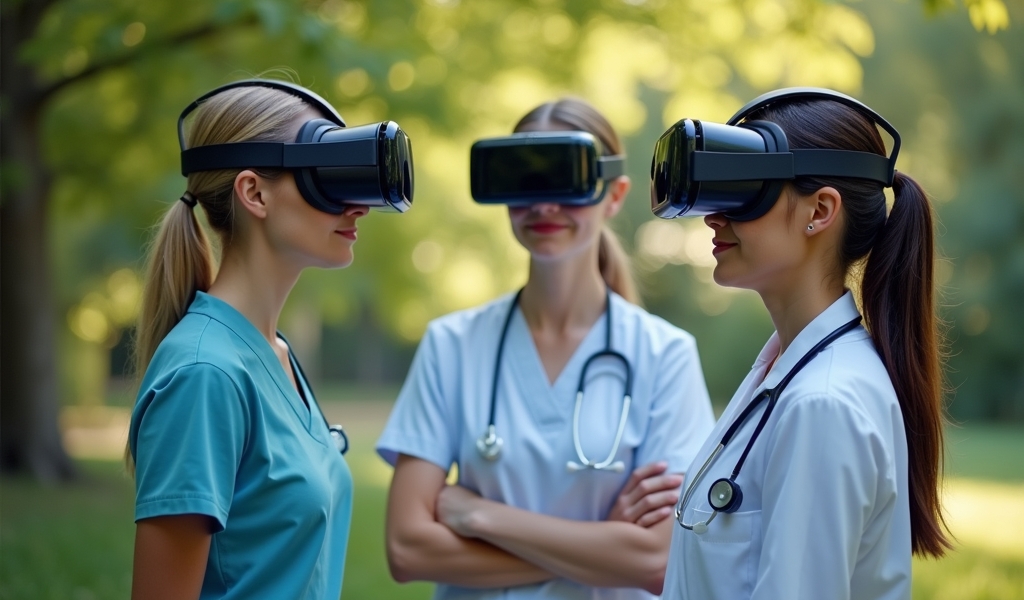Table of Contents
- Revolutionizing Nurse Training: VR and GenAI’s Transformative Impact
- Bridging the Education-Reality Gap in Nursing
- The Multifaceted Benefits of VR and GenAI in Nursing Education
- Telehealth Parallels: What We Can Learn from VR Nursing Training
- Addressing Concerns: Balancing Technology with Human Touch
- The Dr Telx Approach: Technology-Enhanced, Human-Centered Care
- Future Implications for Healthcare Education and Delivery
- Conclusion: Embracing Technological Advancement in Healthcare Education
Revolutionizing Nurse Training: VR and GenAI’s Transformative Impact
A recent article published by Healthcare IT News highlights how North Carolina Central University’s nursing program is leveraging virtual reality (VR) and generative artificial intelligence (GenAI) to transform nurse training. According to the article, students using these technologies report increased confidence, improved time management, and enhanced communication skills when entering clinical settings. The program’s director of experiential learning for nursing, Tina Scott, describes the integration of conversational AI with VR simulations as “amazing” and “very realistic,” creating experiences that closely mimic real-life patient encounters. You can read the full article here.
Bridging the Education-Reality Gap in Nursing
At Dr Telx, we find this innovative approach to nursing education particularly compelling because it addresses a critical gap in healthcare training. The transition from classroom learning to clinical practice has traditionally been jarring for many healthcare professionals. VR simulations with GenAI offer a controlled yet realistic environment where students can develop clinical reasoning and communication skills without risk to actual patients.
This bridging of theory and practice resembles our own philosophy at Dr Telx, where we strive to make healthcare knowledge accessible and applicable to real-world patient situations. The confidence gap described in the article is something we regularly address with our own practitioners, making this technology’s potential particularly relevant to our work.
The Multifaceted Benefits of VR and GenAI in Nursing Education
The article outlines several key benefits of this technological approach to nursing education. Students can prioritize virtual patients, conduct assessments, and document care in real-time – all crucial skills in actual healthcare settings. Importantly, the technology helps students identify gaps in their documentation and clinical reasoning before they enter real clinical environments.
From our perspective at Dr Telx, these benefits extend beyond individual skill development. By training with these technologies, future nurses develop a comfort with digital tools that will be essential in tomorrow’s healthcare landscape. As telehealth providers, we particularly value the emphasis on communication skills within digital environments – a cornerstone of effective virtual care.
Telehealth Parallels: What We Can Learn from VR Nursing Training
The VR nursing simulations share important parallels with telehealth practice. Both require practitioners to develop strong verbal communication skills, attention to detail in digital environments, and the ability to establish rapport without traditional in-person cues. The success of these VR programs suggests that meaningful healthcare connections can be formed in virtual spaces when the technology is thoughtfully implemented.
At Dr Telx, we’ve observed similar patterns in our telehealth practice. Practitioners who excel in virtual care often demonstrate the same skills being cultivated in these VR nursing programs: clear communication, efficient documentation, and the ability to establish trust remotely.
Addressing Concerns: Balancing Technology with Human Touch
While the article presents a largely positive view of VR and GenAI in nursing education, we acknowledge that some may have concerns about overreliance on technology in healthcare training. The human element of healthcare—empathy, intuition, and cultural sensitivity—remains essential.
However, we believe that technology like VR and GenAI can actually enhance these human elements when implemented thoughtfully. By handling routine simulations and providing consistent practice opportunities, these tools free educators to focus on the nuanced, interpersonal aspects of care that define excellent nursing practice.
The Dr Telx Approach: Technology-Enhanced, Human-Centered Care
At Dr Telx, we take a similar approach to our telehealth services. We leverage technology to enhance efficiency and accessibility while maintaining our focus on human connection and personalized care. The VR training described in the article mirrors our philosophy: use technology to improve processes, but keep the human connection at the center.
Our telewellness providers utilize various digital tools to support their practice, but their clinical judgment, empathy, and personalized approach remain the core of our care model. Like the nursing program described, we see technology as an enabler of better human connections, not a replacement for them.
Future Implications for Healthcare Education and Delivery
The success of NCCU’s program suggests exciting possibilities for the future of healthcare education and delivery. As VR and GenAI technologies continue to evolve, we anticipate seeing more sophisticated simulations that can address increasingly complex healthcare scenarios and accommodate diverse learning styles.
For telehealth providers like Dr Telx, these advancements point toward future enhancements in remote care delivery. The skills being developed by students in these programs – digital communication, efficient documentation, and virtual patient assessment – align perfectly with the competencies needed in telehealth practice.
Conclusion: Embracing Technological Advancement in Healthcare Education
The integration of VR and GenAI into nursing education represents a significant step forward in preparing healthcare professionals for modern practice. At Dr Telx, we see these innovations as complementary to our mission of delivering accessible, personal, and modern healthcare. By embracing thoughtful technological advancement while maintaining a focus on human connection, both nursing education and telehealth can evolve to meet the changing needs of patients and practitioners.
As we continue to develop our telewellness model, we’ll be watching developments like NCCU’s program closely, looking for lessons that can enhance our own practice and improve patient outcomes. The future of healthcare lies at this intersection of technological innovation and human compassion – a space where both nursing education and telehealth providers like Dr Telx continue to evolve and excel.

